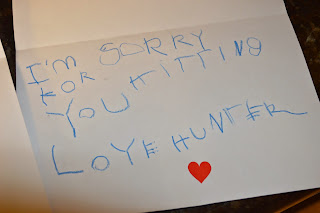Biomedical Review of Nutritional Evaluation
This has been quite the week! Yesterday, we had an appointment with Dr. B to review the NutraEval, Stool sample testing, and OATS testing. My head was swarming when I left, filled with treatment options, areas of defiency, and malabsorption. Here are the key points:
--Hunter has a parasite, called Blastocystis. It was found in his stool and is a typical parasite, one that can be picked up from touching objects, putting your fingers in your mouth, basically transmitted the same way we transfer germs. For Hunter, this parasite is impairing his ability to absorb nutrients. We are treating it with Alinia, to rid his body of the bad bacteria.
--The OATS test (Microbial Organic Acids Test) revealed Dr. B's suspicion. His yeast counts were very high, and he also had the bacteria Clostridia. Both affect the ability to process nutrients in the body. So how does high yeast affect your body?
FROM TACA site...
"The healthy gut contains both yeast and good bacteria, in balance with each other. In many Autism Spectrum Disorder (ASD) kids, however, one or the other can be out of balance. Bacteria can overgrow, or there can be a complete lack of bacteria. Also, bad bacteria can develop and take over, rather than good bacteria, causing major problems for our children.
Bacteria live in the intestinal tract, sharing space with the yeast. Antibiotic use makes yeast worse, or can start off an unhealthy reaction causing yeast overgrowth. Antibiotics kill bacteria, both good and bad, but not yeast. When using antibiotics, the bad bacteria can take over the system and yeast can grow to fill in the space left by the removal of the bacteria.
There are many strains of yeast that live in the digestive tract including candida, which appears to be the most common. There are also several different types of “bad” bacteria, including clostridia and Citrabacter F.
Both good and bad bacteria exist in the gut. Common “good” bacteria, also called beneficial bacteria, are lactobacillus acidophilus and bifidobacterium,
Overgrowth is made possible by a dysfunctional immune system or gastrointestinal distress. A healthy immune system and regular, healthy bowel movements should keep the Candida in check. Occasionally, these complex systems “get out of check” and overgrowth of bad bugs becomes an issue.
Bacteria live in the intestinal tract, sharing space with the yeast. Antibiotic use makes yeast worse, or can start off an unhealthy reaction causing yeast overgrowth. Antibiotics kill bacteria, both good and bad, but not yeast. When using antibiotics, the bad bacteria can take over the system and yeast can grow to fill in the space left by the removal of the bacteria."
So for all of us with healthy immune systems, yeast doesn't cause too many problems. However, when you have a child with a whacky immune system with unfavorable responses, this is problematic.
--Hunter is having a problem with malabsorbtion. Before my dad was diagnosed with Celiac disease, some of the symtoms were related to malabsorption. Hunter showed a HIGH need for supplementation in Lipoic Acid (found in meats, spinach, and broccoli), Thiamin (found in lentils, whole grains, wheat germ, etc), Riboflavin (eggs, milk, cheese, et), Biotin (yeast, whole grains, eggs, cheese, liver, etc), Zinc (oysters, organ meats, soybean, etc), and Vitamin D (mushrooms, sun exposure). He was borderline deficient in several B-Vitamins and minerals, but his antioxidants (including Vitamin A, C, and E) were all in the normal range. Hunter's diet is very clean and healthy, but he definitely is a picky eater. It does go to say, you are what you eat! Make those healthy choices!
As far as treatment, it was recommended to give a powerful multivitamin (we give him Vitaspectrum, mixed in a drink), two antibiotics to rid the yeast and parasite, and then give two types of probitoics- one that replaces good bacteria, and one that fights the bad bacteria. She also encouraged me to find other ways to sneak protein into his diet, including hemp seeds in breads, muffins, etc.
She also wanted me to give him an extra 1000IU of Vitamin D, since he rarely is in the sun, due to his Vitiligo (or he is lathered in sunscreen/wearing a hat). She said that the low zinc count can have toxic affects on the system b/c it counteracts with copper. If zinc is low, copper is high...and it has been studied before how toxic too much copper can be in you body. It is difficult to excrete without zinc. He has mitochondrial dysfunction; it's difficult to open the pathways when they aren't working properly, and not excreting the toxins.
A digestive enzyme was also recommended for a bit after a big meal, since he is having difficulty breaking meals down and grabbing all of the nutrients from it.
The florastor, or probiotics, will be beneficial yeast- it competes with Candida and helps restore normal levels.
Her Five R's in Recovery are:
1) remove the bad
2) Reinoculate/ replace the nutrients lost (good bacteria)
3) Repair with supplements
4) Rebalance the system.
5) Reintroduce
Peter and I like to do one thing at a time to see if they are working, meanwhile taking data. The research looks very optimistic for replacing the good bacteria and taking out the yeast. We will see!
--Hunter has a parasite, called Blastocystis. It was found in his stool and is a typical parasite, one that can be picked up from touching objects, putting your fingers in your mouth, basically transmitted the same way we transfer germs. For Hunter, this parasite is impairing his ability to absorb nutrients. We are treating it with Alinia, to rid his body of the bad bacteria.
--The OATS test (Microbial Organic Acids Test) revealed Dr. B's suspicion. His yeast counts were very high, and he also had the bacteria Clostridia. Both affect the ability to process nutrients in the body. So how does high yeast affect your body?
FROM TACA site...
"The healthy gut contains both yeast and good bacteria, in balance with each other. In many Autism Spectrum Disorder (ASD) kids, however, one or the other can be out of balance. Bacteria can overgrow, or there can be a complete lack of bacteria. Also, bad bacteria can develop and take over, rather than good bacteria, causing major problems for our children.
Bacteria live in the intestinal tract, sharing space with the yeast. Antibiotic use makes yeast worse, or can start off an unhealthy reaction causing yeast overgrowth. Antibiotics kill bacteria, both good and bad, but not yeast. When using antibiotics, the bad bacteria can take over the system and yeast can grow to fill in the space left by the removal of the bacteria.
There are many strains of yeast that live in the digestive tract including candida, which appears to be the most common. There are also several different types of “bad” bacteria, including clostridia and Citrabacter F.
Both good and bad bacteria exist in the gut. Common “good” bacteria, also called beneficial bacteria, are lactobacillus acidophilus and bifidobacterium,
Overgrowth is made possible by a dysfunctional immune system or gastrointestinal distress. A healthy immune system and regular, healthy bowel movements should keep the Candida in check. Occasionally, these complex systems “get out of check” and overgrowth of bad bugs becomes an issue.
Bacteria live in the intestinal tract, sharing space with the yeast. Antibiotic use makes yeast worse, or can start off an unhealthy reaction causing yeast overgrowth. Antibiotics kill bacteria, both good and bad, but not yeast. When using antibiotics, the bad bacteria can take over the system and yeast can grow to fill in the space left by the removal of the bacteria."
So for all of us with healthy immune systems, yeast doesn't cause too many problems. However, when you have a child with a whacky immune system with unfavorable responses, this is problematic.
--Hunter is having a problem with malabsorbtion. Before my dad was diagnosed with Celiac disease, some of the symtoms were related to malabsorption. Hunter showed a HIGH need for supplementation in Lipoic Acid (found in meats, spinach, and broccoli), Thiamin (found in lentils, whole grains, wheat germ, etc), Riboflavin (eggs, milk, cheese, et), Biotin (yeast, whole grains, eggs, cheese, liver, etc), Zinc (oysters, organ meats, soybean, etc), and Vitamin D (mushrooms, sun exposure). He was borderline deficient in several B-Vitamins and minerals, but his antioxidants (including Vitamin A, C, and E) were all in the normal range. Hunter's diet is very clean and healthy, but he definitely is a picky eater. It does go to say, you are what you eat! Make those healthy choices!
As far as treatment, it was recommended to give a powerful multivitamin (we give him Vitaspectrum, mixed in a drink), two antibiotics to rid the yeast and parasite, and then give two types of probitoics- one that replaces good bacteria, and one that fights the bad bacteria. She also encouraged me to find other ways to sneak protein into his diet, including hemp seeds in breads, muffins, etc.
She also wanted me to give him an extra 1000IU of Vitamin D, since he rarely is in the sun, due to his Vitiligo (or he is lathered in sunscreen/wearing a hat). She said that the low zinc count can have toxic affects on the system b/c it counteracts with copper. If zinc is low, copper is high...and it has been studied before how toxic too much copper can be in you body. It is difficult to excrete without zinc. He has mitochondrial dysfunction; it's difficult to open the pathways when they aren't working properly, and not excreting the toxins.
A digestive enzyme was also recommended for a bit after a big meal, since he is having difficulty breaking meals down and grabbing all of the nutrients from it.
The florastor, or probiotics, will be beneficial yeast- it competes with Candida and helps restore normal levels.
Her Five R's in Recovery are:
1) remove the bad
2) Reinoculate/ replace the nutrients lost (good bacteria)
3) Repair with supplements
4) Rebalance the system.
5) Reintroduce
Peter and I like to do one thing at a time to see if they are working, meanwhile taking data. The research looks very optimistic for replacing the good bacteria and taking out the yeast. We will see!


Comments
Post a Comment